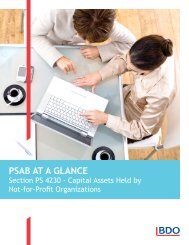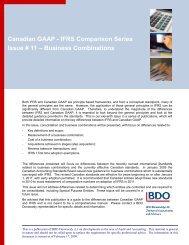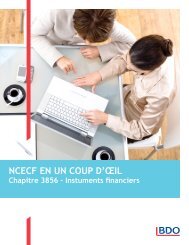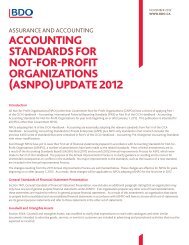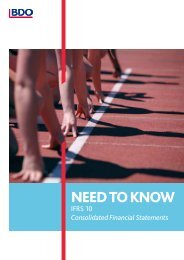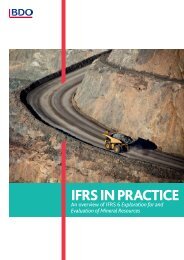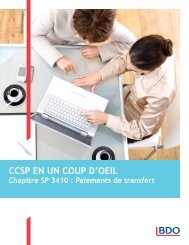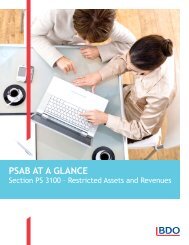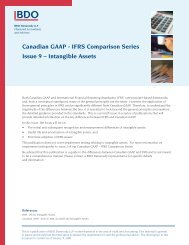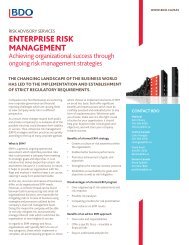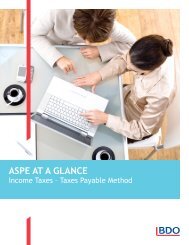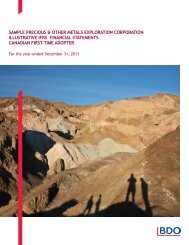PSAB at a Glance: Section PS 3510 - Tax Revenue - BDO Canada
PSAB at a Glance: Section PS 3510 - Tax Revenue - BDO Canada
PSAB at a Glance: Section PS 3510 - Tax Revenue - BDO Canada
You also want an ePaper? Increase the reach of your titles
YUMPU automatically turns print PDFs into web optimized ePapers that Google loves.
<strong><strong>PS</strong>AB</strong> AT A GLANCE<strong>Section</strong> <strong>PS</strong> <strong>3510</strong> – <strong>Tax</strong> <strong>Revenue</strong>
March 2013<strong>Section</strong> <strong>PS</strong> <strong>3510</strong> – <strong>Tax</strong> <strong>Revenue</strong>Effective D<strong>at</strong>eFiscal periods beginning on or after April 1, 2012SCOPEApplies to:• Accounting for andreporting tax revenue ingovernment financialst<strong>at</strong>ements.Does not apply to:• <strong>Revenue</strong> recognition of developer charges, which is addressed in <strong>PS</strong> 3100, Restricted Assets and <strong>Revenue</strong>s;• <strong>Revenue</strong> recognition of resource royalties;• Fines or penalties, such as those imposed for breaches of tax law;• Interest earned on tax receivables;• Transactions th<strong>at</strong> are more in the n<strong>at</strong>ure of exchange transactions, such as user fees, license or permit fees; or• Non-compulsory transfers to the government or entities charged with tax collection for the government, such as don<strong>at</strong>ions, contributions and the payment of fees.• Economic resources compulsorily paid or payable to governments in accordance with laws and / or regul<strong>at</strong>ions normally established to provide revenue for public purposes to the government.• <strong>Tax</strong> transactions are non-exchange transactions.• A major source of revenue for governments.TAXESRECOGNITION• <strong>Tax</strong>es must be recognized as assets and revenues when:• They meet the definition of an asset set out in <strong>PS</strong> 1000, Financial St<strong>at</strong>ement Concepts;• They are authorized as described in paragraph <strong>PS</strong> <strong>3510</strong>.17; and• The taxable event occurs.• A government only recognizes tax revenue it expects to collect in accordance with the general recognition criteria set out in paragraph <strong>PS</strong> 1000.55.ATTRIBUTION OF TAX REVENUEAUTHORIZATIONTHE TAXABLE EVENTTAXES RECEIVEDIN ADVANCE• A government is considered to have imposed a tax and would recognize tax revenue if the governmentdirectly levies the tax:• By exercising the taxing authority provided in its own legisl<strong>at</strong>ion, regul<strong>at</strong>ions or by-laws (for example,income taxes); or• In accordance with the taxing authority granted to it in the legisl<strong>at</strong>ion of another level of government(for example, municipalities granted taxing authority under provincial legisl<strong>at</strong>ion).TAXES IMPOSED / COLLECTED ON BEHALF OF OTHERS• Pursuant to an existing agreement / legisl<strong>at</strong>ion in place <strong>at</strong> the financial st<strong>at</strong>ement d<strong>at</strong>e th<strong>at</strong> is purely aflow-through arrangement; a government may impose a tax on behalf of another government or otherpublic sector entity.• When amounts are collected by an agent of the government / other third party these amounts do notincrease the net assets or revenue of the agent.• The government imposing / collecting the tax on behalf of others does not recognize tax revenue.• For revenue recognition purposes <strong>at</strong>ax is considered authorized by alegisl<strong>at</strong>ure / council when theeffective d<strong>at</strong>e of the tax haspassed and the earlier of thefollowing has occurred:• The legisl<strong>at</strong>ure / council hasapproved the rel<strong>at</strong>edlegisl<strong>at</strong>ion, regul<strong>at</strong>ions or bylaws;or• Through legisl<strong>at</strong>ive conventionthe ability to assess and collecttax has been provided.• Refer to paragraph <strong>PS</strong><strong>3510</strong>.19 for more inform<strong>at</strong>ionon legisl<strong>at</strong>ive convention.• The event th<strong>at</strong> thegovernment, legisl<strong>at</strong>ure,council or other authorityhas determined will besubject to tax<strong>at</strong>ion.• To determine wh<strong>at</strong> thetaxable event is for thevarious taxes levied forthe purposes ofparagraph <strong>PS</strong> <strong>3510</strong>.08, agovernment examinesthe tax law in its ownjurisdiction.• Refer to paragraph <strong>PS</strong><strong>3510</strong>.20 for examples oftaxable events.• If taxes arereceived in advanceof the recognitioncriteria set out inparagraph <strong>PS</strong><strong>3510</strong>.08 being met,they are recognizedas a liability untilthe recognitioncriteria are met,which is normallyas the taxableevent occurs.
MEASUREMENTINITIAL MEASUREMENT• An asset th<strong>at</strong> is acquired through a tax transaction must be initially measured <strong>at</strong> is realizable value <strong>at</strong> the d<strong>at</strong>e of acquisition.• Realizable value is the amount of cash or cash equivalents th<strong>at</strong> an asset is expected to be converted into in the due course of oper<strong>at</strong>ions.• Any adjustments to tax revenue resulting from a change in estim<strong>at</strong>e are accounted for in accordance with <strong>Section</strong> <strong>PS</strong> 2120, Accounting Changes.• If a government receives other types of assets to settle outstanding taxes receivable, these assets are measured <strong>at</strong> their fair value as <strong>at</strong> the d<strong>at</strong>e of acquisition by the government to determine whether they settlethe entire tax receivable or whether a balance receivable remains or a refund is owed.• Administr<strong>at</strong>ive costs or other expenses rel<strong>at</strong>ed to tax revenue transactions are recognized separ<strong>at</strong>e from tax revenue as an expense rel<strong>at</strong>ed to the transaction.SUBSEQUENT MEASUREMENT• A government must evalu<strong>at</strong>e the likelihood of having to repay taxes collected under tax measures deemed to be authorized using the concept of legisl<strong>at</strong>ive convention set out in paragraph <strong>PS</strong> <strong>3510</strong>.17(b) andrecognize a liability when required by <strong>Section</strong> <strong>PS</strong> 3200, Liabilities, <strong>at</strong> each financial st<strong>at</strong>ement d<strong>at</strong>e.• Rel<strong>at</strong>ed refunds must be accounted for as a change in estim<strong>at</strong>e in accordance with <strong>PS</strong> 2120, Accounting Changes.TRANSFERS MADE THROUGH A TAX SYSTEM AND TAX CONCESSIONS• Transfers made through a tax system must be recognized as an expense, not as a reduction of tax revenue.• <strong>Tax</strong> revenue cannot be grossed up for the amount of tax concessions.• In determining whether to classify a payment or reduction in taxes payable as a transfer made through a tax system or as a tax concession professional judgment must be applied. The following would beconsidered by a government when classifying an item:• The definitions of tax concessions and transfers made through a tax system set out in paragraph <strong>PS</strong> <strong>3510</strong>.07;• The criteria set out in paragraphs <strong>PS</strong> <strong>3510</strong>.37-.44; and• The decision tree provided in Appendix A to <strong>PS</strong> <strong>3510</strong>.TRANSFERS MADE THROUGH A TAX SYSTEM• Financial benefits provided or determined through a tax system th<strong>at</strong> are made for a purpose otherthan the relieving of taxes previously paid or currently owing.• Refer to paragraphs <strong>PS</strong> <strong>3510</strong>.37-.41 for additional guidance.TAX CONCESSIONS• Referential provisions of the tax law th<strong>at</strong> are only available to taxpayers and can include exemptions,deductions, deferrals and credits th<strong>at</strong> affect the level and distribution of tax.• May include special tax r<strong>at</strong>es.• Provide tax relief of taxes previously paid or currently owing and are seen as "foregone revenue".• Often referred to as "tax expenditures".• Refer to paragraphs <strong>PS</strong> <strong>3510</strong>.42-.44 for additional guidance.
N<strong>at</strong>ional Office36 Toronto StreetSuite 600Toronto ON M5C 2C5800 805 9544www.bdo.caThis public<strong>at</strong>ion has been carefully prepared, but it has been written in general terms and should be seen as broadguidance only. The public<strong>at</strong>ion cannot be relied upon to cover specific situ<strong>at</strong>ions and you should not act, or refrainfrom acting, upon the inform<strong>at</strong>ion contained therein without obtaining specific professional advice. Please contact<strong>BDO</strong> <strong>Canada</strong> LLP to discuss these m<strong>at</strong>ters in the context of your particular circumstances. <strong>BDO</strong> <strong>Canada</strong> LLP, itspartners, employees and agents do not accept or assume any liability or duty of care for any loss arising from anyaction taken or not taken by anyone in reliance on the inform<strong>at</strong>ion in this public<strong>at</strong>ion or for any decision based on it.<strong>BDO</strong> <strong>Canada</strong> LLP, a Canadian limited liability partnership, is a member of <strong>BDO</strong> Intern<strong>at</strong>ional Limited, a UK companylimited by guarantee, and forms part of the intern<strong>at</strong>ional <strong>BDO</strong> network of independent member firms. <strong>BDO</strong> is thebrand name for the <strong>BDO</strong> network and for each of the <strong>BDO</strong> Member Firms.



